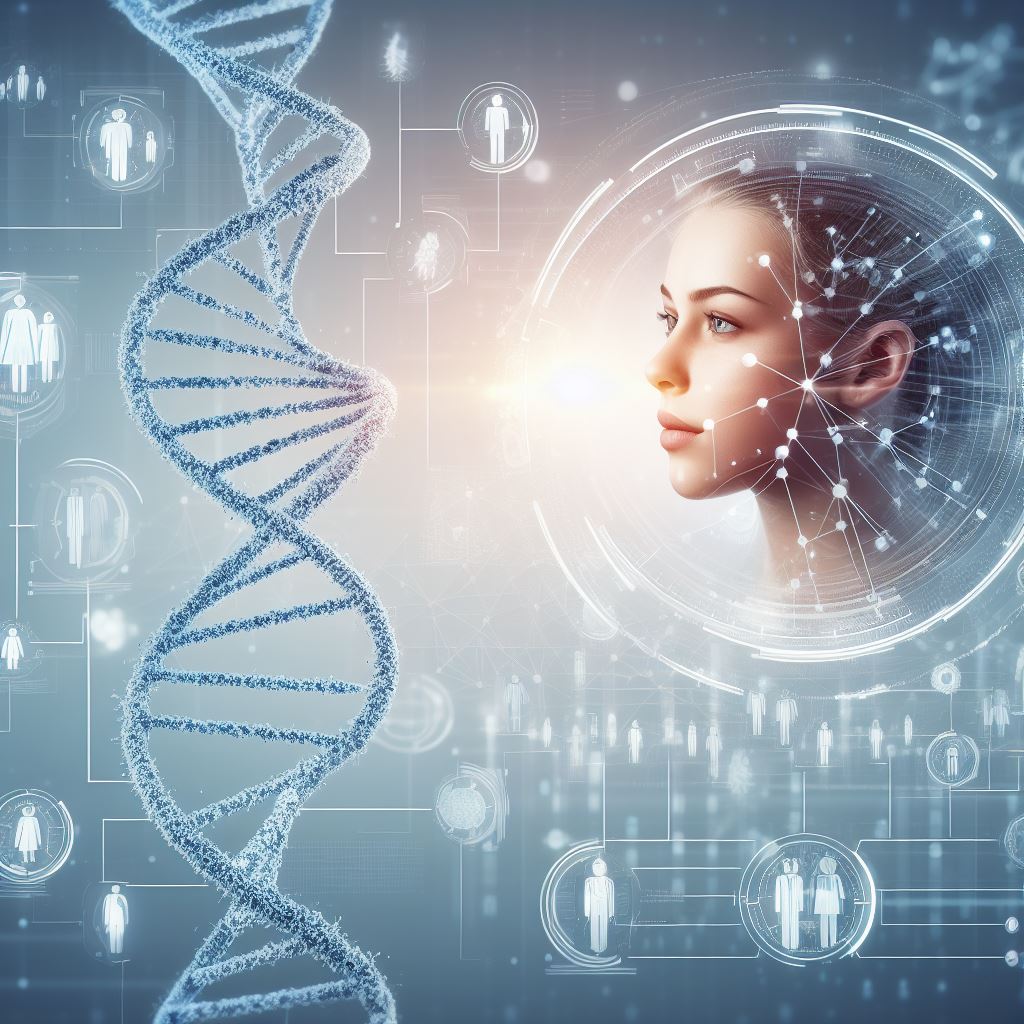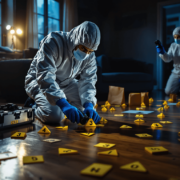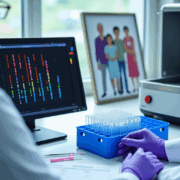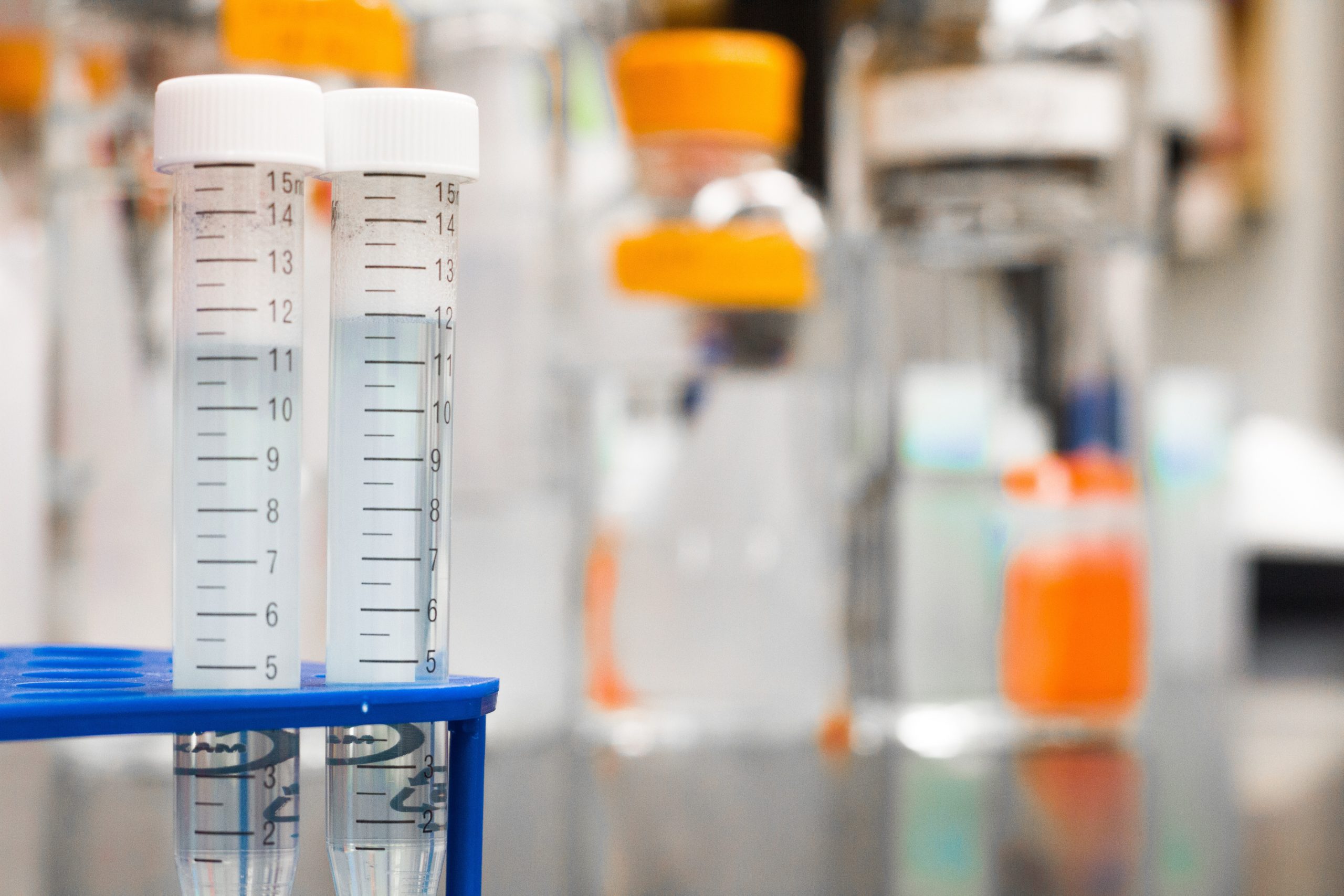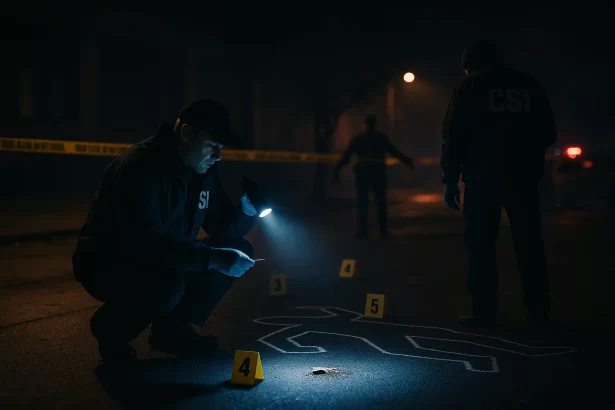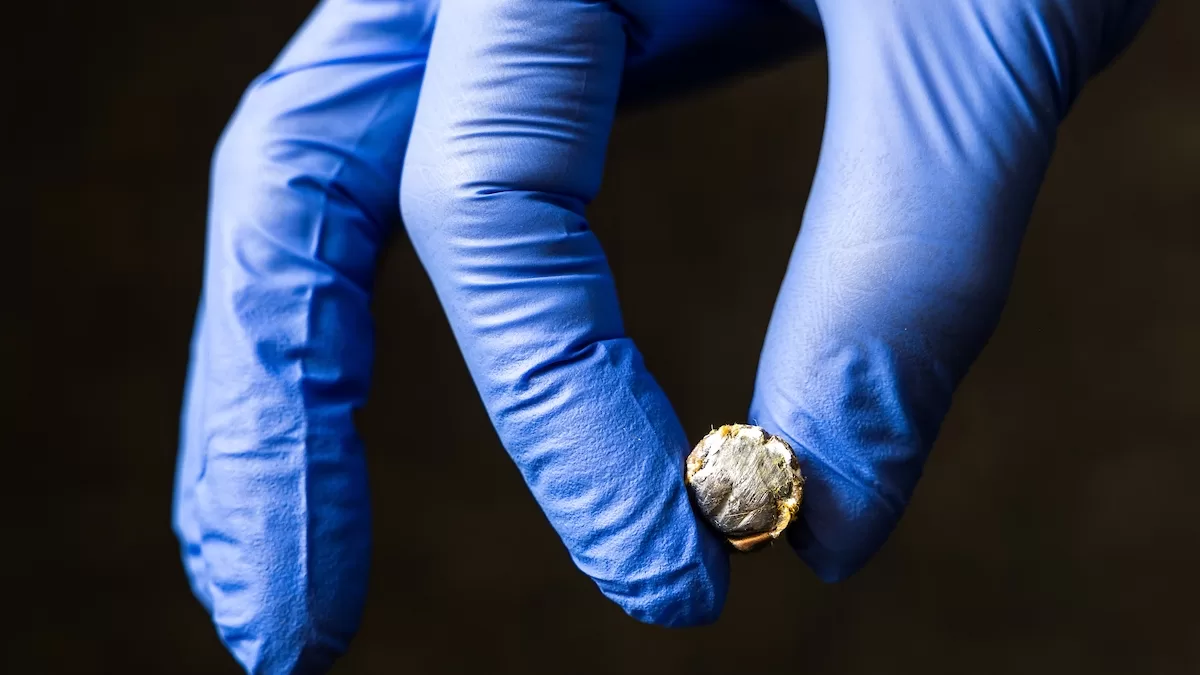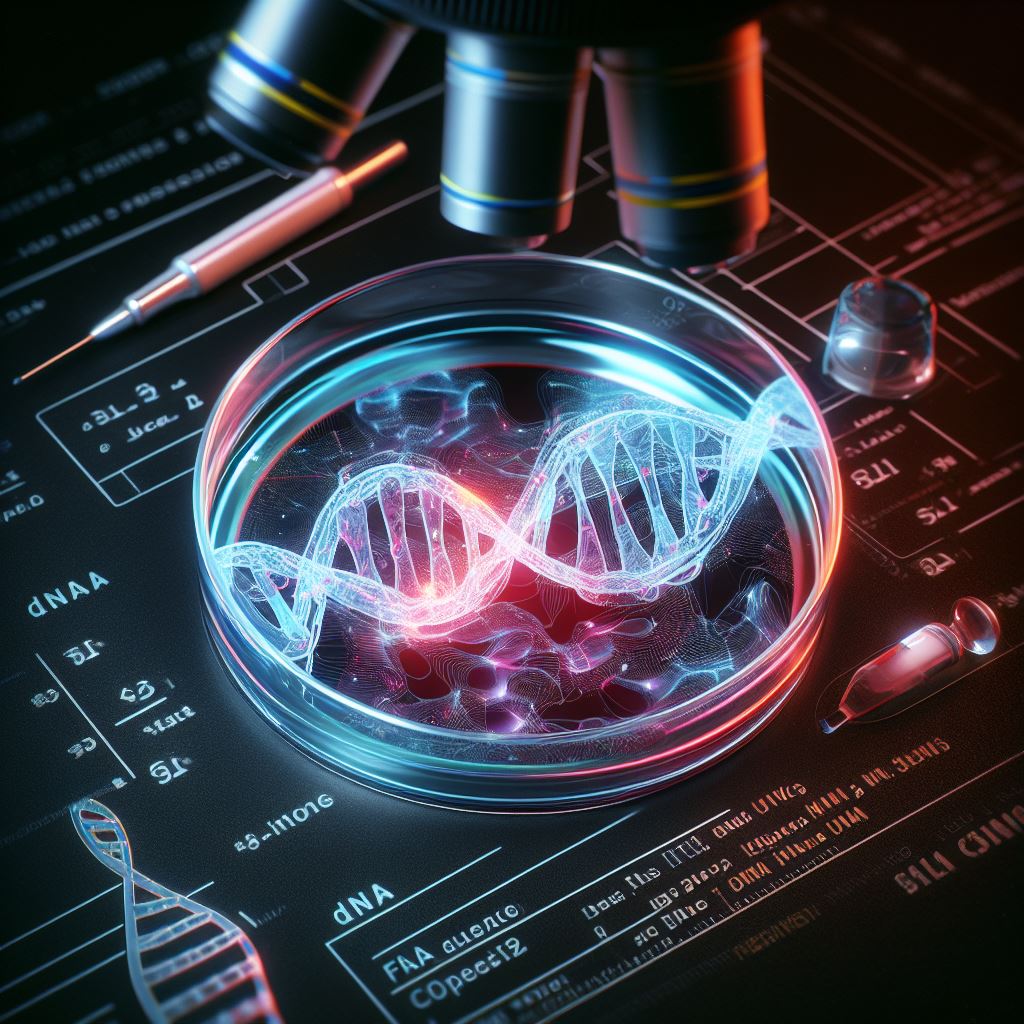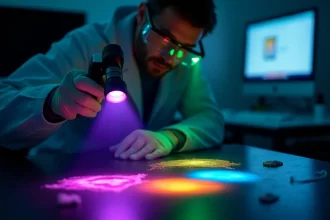Did you know that 85% of crime scene evidence can be compromised within the first hour of discovery? Whether you’re a seasoned investigator or new to the field, proper crime scene investigation requires meticulous attention to detail and strict protocol adherence. In fact, the difference between solving a case and hitting a dead end often comes down to those crucial first hours of processing the scene. Crime scene processing is vital to any criminal investigation, serving as the foundation for gathering evidence and solving crimes.
A crime scene is a rich source of evidence that can be used to piece together the events surrounding a crime. The scene must be handled correctly to ensure the evidence gathered is admissible in court.
The systematic application of critical steps in crime scene processing creates a framework that guides investigators through complex scenes while maintaining scientific rigor and procedural compliance.
Understanding Crime Scene Processing Fundamentals
The foundation of a successful criminal investigation lies in the meticulous processing of the crime scene. This involves a series of critical steps that ensure the collection, documentation, and preservation of evidence in a manner that is admissible in court.
Crime scene processing is not just about collecting evidence; it’s about doing so in a way that maintains its integrity and ensures its usefulness in the investigation and subsequent legal proceedings.
The Importance of Proper Crime Scene Management
Proper crime scene management is crucial for preventing contamination and ensuring that evidence is handled correctly. This includes securing the scene, controlling access, and documenting every step of the process.
- Securing the crime scene to prevent unauthorized access and potential contamination of evidence.
- Documenting the scene through photographs, videos, and detailed notes to create a permanent record.
- Collecting and preserving physical evidence in a manner that maintains its integrity.
Effective crime scene management is essential for the successful investigation and prosecution of crimes, as it directly impacts the quality and reliability of the evidence presented in court.
Legal Implications of Crime Scene Evidence
The admissibility of crime scene evidence in court is contingent upon its proper collection, documentation, and preservation. Courts scrutinize the chain of custody to ensure evidence integrity.
Investigators must understand the legal thresholds for different types of evidence, including direct, circumstantial, and trace evidence. The ability to articulate and defend methodological choices during crime scene processing directly impacts evidence admissibility determinations.
Step 1: Securing the Crime Scene
Effective crime scene management begins with locking down the scene to ensure the integrity of the evidence. This initial step is crucial in preventing contamination and preserving the crime scene in its original state.
Establishing Crime Scene Perimeters
Establishing a crime scene perimeter involves creating a physical barrier around the scene to control access. This is typically achieved using police tape to demarcate the area. The process of isolating the crime scene inside this perimeter is known as locking down the crime scene. By doing so, investigators can prevent unauthorized individuals from entering the scene and potentially contaminating evidence.
Controlling Access to Prevent Contamination
Controlling access to the crime scene is vital to prevent contamination. This involves implementing access control protocols, including systematic documentation of all personnel entering and exiting the secured perimeter. A single entry/exit point should be established to facilitate monitoring and documentation. Furthermore, a crime scene log should be maintained to record all individuals who access the scene, their purpose, and duration within the perimeter.
First responders and investigators must be instructed on the importance of contamination prevention to effectively control access and prevent contamination. This includes wearing appropriate personal protective equipment (PPE) to prevent investigator-introduced contamination. Equipment brought into the scene should also be documented to maintain the integrity of the evidence.
| Access Control Measure | Purpose |
|---|---|
| Establishing a single entry/exit point | Facilitates monitoring and reduces contamination risks |
| Maintaining a crime scene log | Creates an official record of scene access |
| Using personal protective equipment (PPE) | Prevents investigator-introduced contamination |
By effectively securing the crime scene, investigators can ensure that the evidence collected is reliable and admissible in court.
Step 2: Conducting the Initial Assessment
The initial assessment is a pivotal moment in crime scene investigation, requiring a meticulous approach to evidence recognition. This phase is critical as it sets the foundation for the entire investigation, determining the course of action for collecting and processing evidence.
During the initial assessment, investigators must carefully survey the crime scene to identify all areas where potential evidence may be located. This involves understanding the dynamics of the crime, including the interactions between the suspect, victim, and the environment.
Identifying the Scope of the Crime Scene
Identifying the scope of the crime scene is essential to ensure that all relevant areas are processed for evidence. The crime scene includes all areas where the suspect has had any interaction or activity, including points of entry and exit, and where the interaction between the suspect and victim occurred.
For instance, in cases where there is extended interaction between a suspect and a victim over time and across different locations, investigators may need to define one large crime scene or multiple smaller crime scene areas. This determination is crucial for setting appropriate crime scene perimeters.
| Crime Scene Characteristics | Description |
|---|---|
| Points of Entry and Exit | Areas where the suspect entered or left the crime scene |
| Interaction Areas | Locations where the suspect and victim interacted |
| Evidence Locations | Areas where potential evidence is found |
Recognizing Potential Evidence Types
Recognizing potential evidence types is a critical aspect of the initial assessment. Investigators must be knowledgeable about various evidence categories, including biological (such as blood, saliva, and hair), trace (like fibers, soil, and glass), impression (including fingerprintsFingerprint, impression made by the papillary ridges on the ends of the fingers and thumbs. Fingerprints afford an infallible means of personal identification, because the ridge arrangement on every finger of every human being is unique and does not alter with growth or age. Fingerprints serve to reveal an individual’s true identity despite personal denial, assumed names, or changes in personal appearance resulting from age, disease, plastic surgery, or accident. The practice of utilizing fingerprints as a means of identification, referred to as dactyloscopy, is an indispensable aid to modern law enforcement. More, footwear, and tire tracks), and digital evidence.
As noted by forensic experts, “The initial assessment phase involves identifying both obvious and latent evidence, requiring investigators to anticipate evidence that may not be immediately visible.”
“Evidence recognition requires a comprehensive understanding of the different types of evidence and their potential value in reconstructing the sequence of events.”
- Biological evidence, such as bloodstains, can provide crucial DNADNA, or Deoxyribonucleic Acid, is the genetic material found in cells, composed of a double helix structure. It serves as the genetic blueprint for all living organisms. More information.
- Trace evidence, like fibers and soil, can link suspects to crime scenes.
- Impression evidence, including fingerprints and footwear marks, can directly identify suspects.
The initial assessment is a complex process that requires investigators to be thorough and meticulous in identifying and documenting potential evidence. Doing so ensures that the subsequent investigation is well-informed and practical.
Step 3: Documenting the Crime Scene
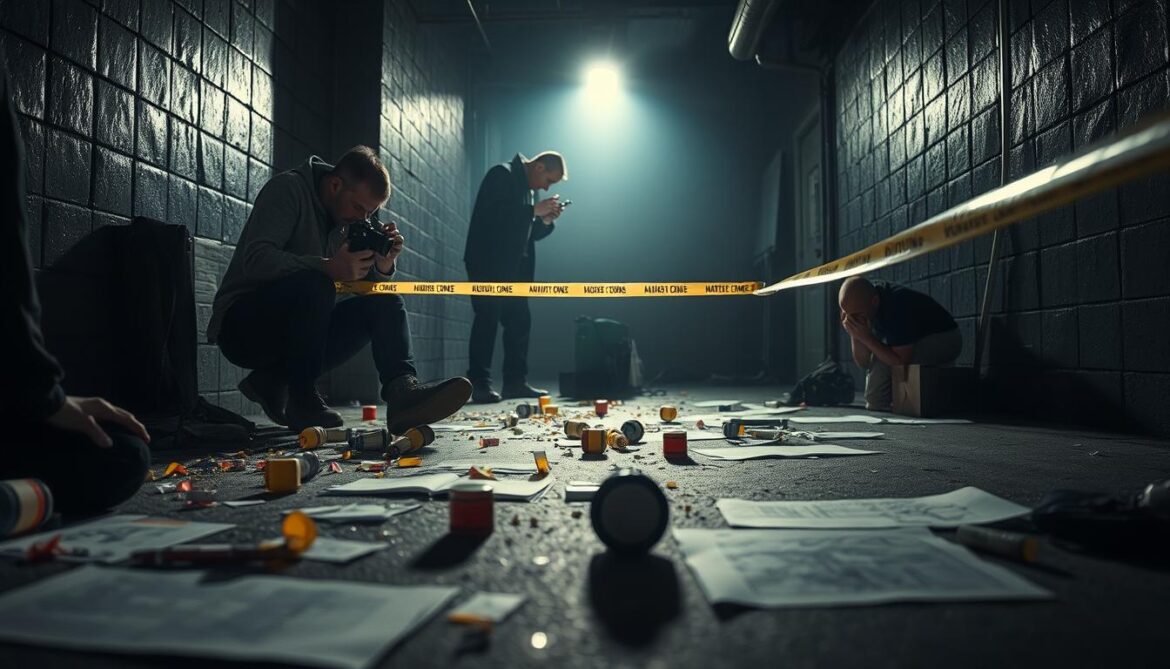
The documentation phase is crucial in the systematic processing of a crime scene. It involves creating a comprehensive and accurate record of the scene, which is vital for further investigation and potential court proceedings.
Photography and Video Documentation Techniques
Photography and video recording are essential tools for documenting the crime scene. These visual records provide a permanent and detailed account of the scene, capturing evidence and contextual information that may be critical to the investigation.
Effective forensic photography techniques include taking overall views of the scene, followed by mid-range and close-up shots of specific evidence items. Video documentation can provide a more immersive view of the scene, helping investigators better understand the spatial relationships between different elements.
Creating Detailed Sketches and Notes
Beyond visual documentation, creating detailed sketches and notes is crucial. Sketches provide spatial context and precise measurements that photographs cannot capture, while notes document observations beyond visual elements.
- Crime scene sketches establish precise measurements and relationships between evidence items and fixed reference points.
- Comprehensive notes document environmental conditions, odors, temperatures, and other sensory information relevant to the investigation.
- Note-taking protocols require contemporaneous documentation with clear indications when notes are made after the fact.
The investigator’s notebook is a critical tool, serving as a personal reference for recording the investigation. It should be maintained with care, following established protocols for content and format.
Step 4: Collecting Physical Evidence
Collecting physical evidence is a critical step in crime scene processing that requires meticulous attention to detail and adherence to established protocols. The integrity of the evidence collected directly impacts the outcome of forensic analysis and, subsequently, the investigation’s success.
Proper Evidence Collection Protocols
Proper evidence collection protocols are essential to prevent contamination and ensure the reliability of the evidence. Investigators must follow strict guidelines when handling evidence, including wearing appropriate personal protective equipment (PPE) to prevent cross-contamination. As noted by forensic experts, “The handling of evidence is a critical aspect of the investigative process, requiring meticulous care to preserve its integrity.”
The use of sterile equipment and storage materials is also crucial. Evidence should be packaged to prevent damage or degradation during transportation to the laboratory. For instance, biological evidence requires specific handling protocols, including appropriate drying procedures before packaging and temperature-controlled storage.
Handling Different Types of Physical Evidence
Different types of physical evidence necessitate specialized handling techniques. For example, trace evidence collection employs techniques such as tape lifting and vacuuming to preserve microscopic materials. Impression evidence, on the other hand, requires careful photography before collection and the use of specialized casting materials for three-dimensional impressions.
Other types of evidence, such as digital, firearm, and tool mark evidence, also require unique handling protocols. Digital evidence, for instance, demands specialized knowledge of proper shutdown procedures and forensic imaging techniques to prevent data loss or corruption. Firearms and tool mark evidence handling protocols focus on preserving forensically significant markings through proper packaging and transportation.
By understanding and implementing these specialized handling techniques, investigators can ensure that various types of physical evidence are collected and preserved effectively, ultimately contributing to a successful investigation.
Step 5: Processing the Evidence
Processing evidence is a critical phase in crime scene investigation that requires meticulous attention to detail to prevent contamination and maintain chain of custody. This step is crucial in ensuring that the evidence collected is reliable, admissible in court, and useful in reconstructing the crime scene.
Labeling and Packaging Evidence
Proper labeling and packaging of evidence are essential to prevent contamination and ensure that evidence items are securely stored and transported. Each item must be carefully labeled with relevant information, including the case number, item description, and the collector’s initials. Packaging materials should be chosen based on the type of evidence to prevent damage or degradation. For instance, biological evidence should be packaged in breathable containers to prevent moisture buildup.
Maintaining Chain of Custody
Maintaining the chain of custody is vital to establish the integrity and authenticity of evidence. This involves creating a detailed record of every individual who handles the evidence, from collection to presentation in court. The chain of custody documentation should include the reason for transfer, personnel involved, and precise timing of custody changes. Digital chain of custody systems can enhance traditional documentation methods by providing automated tracking and reducing administrative errors.
- Chain of custody documentation creates an unbroken record of evidence possession, establishing evidence integrity.
- Proper chain of custody procedures address temporary storage situations, with secure evidence storage facilities and access logs.
- Training for all personnel handling evidence emphasizes the critical nature of the chain of custody documentation and proper transfer procedures.
By following these protocols, investigators can ensure that evidence is handled and processed in a manner that maintains its integrity and supports a successful investigation.
Step 6: Conducting Witness and Victim Interviews
Conducting witness and victim interviews is a crucial step in crime scene processing that requires meticulous planning and execution. The information gathered from these interviews can significantly impact the investigation’s outcome, making it essential to approach this task systematically and thoroughly.
Interview Techniques for Crime Scene Investigations
Effective interview techniques are vital in crime scene investigations. Investigators must create an environment where witnesses and victims feel comfortable sharing their accounts. This involves active listening and empathy, ensuring that the interviewee’s statement is captured accurately. The use of open-ended questions can encourage detailed responses, while follow-up questions can clarify any ambiguities in the witness’s or victim’s account.
Additionally, investigators should be aware of the potential for witness intimidation or discomfort, taking steps to mitigate these factors. The goal is to obtain a clear, concise, and accurate account of the events in question.
Documenting Witness Statements
Documenting witness statements is a critical aspect of the interview process. This involves recording the statement and ensuring that it maintains its evidentiary value. Methods of documentation include written statements, audio or video recordings, and investigator notes. Each method has its protocols to ensure accuracy and completeness.
For instance, the witness should review and verify written statements with signatures and date/time documentation to authenticate the content. Digital recording technology can provide a verbatim account, but it also raises considerations regarding storage, transcription, and authenticationVerifying the identity of a user, process, or device, often as a prerequisite to allowing access to resources in an information system. More.
Proper documentation distinguishes between direct observations and hearsay information, clarifying the evidentiary weight of different statement components. It also includes contextual information about the interview circumstances, such as location, persons present, and witness demeanor during the interview.
The 12 Critical Steps of Crime Scene Processing: Steps 7-9

As the crime scene investigation progresses, the next critical steps involve analyzing the collected evidence, reconstructing the crime scene, and preparing a comprehensive investigative report. These steps are crucial in piecing together the events surrounding the crime and ensuring that justice is served.
Step 7: Analyzing the Evidence
Analyzing the evidence is a meticulous process that involves examining each piece of evidence in detail. This step is critical in identifying the evidence’s relevance and significance to the case. Investigators use various techniques and tools to analyze the evidence, including forensic analysis and expert interpretation. The analysis helps establish connections between different pieces of evidence and form a coherent picture of the crime.
Key aspects of evidence analysis include:
- Forensic examination of physical evidence
- Expert interpretation of evidence
- Identifying patterns and connections between evidence
Step 8: Reconstructing the Crime Scene
Reconstructing the crime scene involves using the analyzed evidence to recreate the sequence of events surrounding the crime. This step helps investigators to understand how the crime was committed and to identify potential suspects. Crime scene reconstruction requires a thorough understanding of the evidence and its context within the crime scene.
The process involves:
- Using evidence to recreate the crime sequence
- Analyzing the spatial relationships between evidence
- Considering different scenarios and testing hypotheses
Step 9: Preparing the Investigative Report
Preparing the investigative report is the final step in the crime scene processing. The report must be thorough, accurate, and comprehensive, including all evidence and witness statements. It serves as the foundation for prosecution decisions and subsequent court proceedings.
Key elements of the investigative report include:
- Detailed description of the crime scene
- Documentation of evidence collection and analysis
- Witness statements and testimonies
- Investigative actions and findings
The investigative report is a critical document that communicates the investigation’s findings to prosecutors, defense attorneys, and the court. It must be prepared with meticulous attention to detail and accuracy.
Step 10: Reviewing and Analyzing the Report
A meticulous investigative report review and analysis are conducted to identify any discrepancies or gaps. This step is crucial in ensuring that the crime scene investigation is thorough and that the evidence collected is accurate and reliable.
Quality Control in Crime Scene Reports
The review process involves a thorough examination of the report to ensure that it meets the required standards. This includes checking for any inconsistencies in the documentation of evidence, verifying that all evidence is properly labeled and stored, and confirming that the chain of custody has been maintained.
Quality controlQuality control (QC) refers to a series of activities and measures conducted on individual laboratory tests or analyses to verify and ensure the accuracy and reliability of the results. QC is a reactive approach that aims to identify and rectify issues or defects in the specific test or measurement being performed. Here are key points about quality control: • Test-Specific: QC focuses on the accuracy and precision of individual laboratory tests or analytical procedures. It assesses the performance of each test separately.
• Verification of Results: The primary goal of QC is to verify that the results obtained from a specific test or measurement are accurate and reliable. It checks whether the data generated meet established quality criteria.
• Identification of Problems: QC activities are designed to identify problems or errors in the test run as they occur. It allows for immediate corrective actions to be taken.
• Monitoring Consistency: QC measures aim to ensure the consistency of results over time. By tracking and comparing results from different runs or batches, laboratories can detect deviations from expected values.
• Tools and Controls: QC may involve the use of various tools and controls, such as blanks, internal standards, negative controls, and positive controls. These are employed to assess the accuracy and precision of the test for a specific batch or set of samples.
• Data Analysis: QC data are analyzed to determine if the test results fall within predefined acceptance criteria or quality specifications. Deviations from these criteria trigger further investigation.
• Maintenance and Calibration: Routine calibration and maintenance of laboratory equipment and instruments are part of QC activities. Regular checks ensure that equipment is operating correctly.
• Troubleshooting: QC identifies issues or irregularities in real time, allowing laboratory personnel to troubleshoot problems and take corrective actions promptly.
• Compliance: QC procedures often involve compliance with established standards, protocols, and guidelines specific to the type of testing being conducted.
• Documentation: Accurate documentation of QC data, actions taken, and any deviations from expected results is crucial. Records provide a historical record of the test's performance.
• Comparison to Quality Assurance (QA): While QC is focused on individual tests and measurements, quality assurance (QA) encompasses a broader approach that addresses the overall quality of laboratory operations and processes. QA aims to prevent errors proactively and improve processes, whereas QC reacts to issues as they arise.
• Risk Mitigation: QC also contributes to risk mitigation by ensuring that individual tests meet established quality standards and criteria. It helps prevent incorrect or unreliable results from being reported.
In summary, quality control (QC) in a laboratory setting involves measures and activities to verify the accuracy and reliability of individual test results. It is a reactive approach that identifies and corrects issues specific to a particular test or analysis. QC is an essential component of ensuring the integrity and quality of laboratory data. More measures are essential in this phase to guarantee the integrity of the investigation. These measures include:
- Verifying the accuracy of the documented evidence
- Ensuring that all evidence is properly preserved and stored
- Confirming that the chain of custody procedures has been followed
Addressing Discrepancies and Gaps
Any discrepancies or gaps identified in the report must be addressed during the review. This involves:
- Discrepancy resolution processes to identify contradictions between different evidence sources
- Gap analysis to evaluate the completeness of the investigation
- Resolution protocols, including follow-up investigations or supplemental forensic analysis
- Documentation standards that require transparent acknowledgment of resolved discrepancies
The review process also evaluates alternative explanations for the evidence, ensuring that investigators have considered and addressed reasonable defense theories. Any unresolved discrepancies receive particular attention, with documentation of investigative efforts and potential explanations for contradictory evidence.
Step 11: Presenting Evidence in Court
Evidence gathered during crime scene processing must be presented effectively in court to support the prosecution’s case. The prosecution must be able to prove that the evidence was collected and processed correctly and that it is relevant to the case.
Preparing for Testimony
Preparing for testimony involves several key steps to ensure that the investigator can effectively communicate the significance of the evidence. This includes reviewing the case files, organizing the evidence, and anticipating potential questions from the defense. Effective testimony preparation is crucial for presenting a clear and convincing narrative.
The investigator should also be familiar with the legal procedures and the rules of evidence to ensure that the presentation is compliant with court requirements. This preparation helps to establish the credibility of the evidence and the investigator.
Effective Evidence Presentation Strategies
Effective presentation strategies are essential for translating complex forensic concepts into accessible explanations. This can be achieved through the use of visual aids such as photographs, diagrams, and physical exhibits, which help to create a clear understanding of the crime scene conditions and evidence relationships.
Additionally, the presentation should address the chain of custody comprehensively, establishing evidence integrity through clear documentation of handling procedures. Modern court presentations increasingly incorporate digital reconstruction and multimedia elements to enhance juror understanding.
Step 12: Following Up on the Investigation
The last of the 12 critical steps in crime scene processing is following up on the investigation, a crucial phase for case closure and professional growth. This step is essential for ensuring that justice is served and that the investigative process is continually improved.
Post-Trial Procedures
After the trial, investigators must engage in post-trial procedures to review the case outcome and document any lessons learned. This involves evaluating the effectiveness of the evidence presented and identifying areas where the investigative process could be improved. Formal debriefing sessions are conducted to analyze procedural decisions, evidence collection techniques, and presentation strategies. These sessions are critical for continuous improvement and for refining investigative protocols.
Case Review and Continuous Improvement
The case review process is vital to following up on an investigation. It involves a thorough examination of the investigative methods used, the evidence collected, and the trial outcomes. By analyzing these factors, investigators can identify successful techniques and areas for improvement. Continuous improvement initiatives are then implemented to translate these findings into procedural modifications, training programs, and equipment upgrades. This ensures that future investigations benefit from the knowledge gained and that the investigative community as a whole can learn from the case.
By following these steps, investigators can ensure that their work is thorough, effective, and continually improving. This not only aids in achieving justice in individual cases but also contributes to the broader goal of enhancing the integrity and effectiveness of the criminal justice system.
Conclusion: Ensuring Justice Through Proper Crime Scene Processing
Effective crime scene processing stands as a cornerstone in the pursuit of justice. By meticulously following the 12 critical steps outlined in this article, investigators can ensure that evidence is properly collected, processed, and analyzed, thereby strengthening the foundation of a criminal investigation.
Proper crime scene processing cannot be overstated. It forms the bedrock of effective criminal justice outcomes, with each step contributing significantly to the ultimate goal of truth determination. The systematic application of these steps creates a framework that balances thoroughness with efficiency, ensuring comprehensive evidence collection while recognizing practical limitations.
Technological advancements continue to enhance crime scene processing capabilities, with new tools for detection, documentation, and analysis expanding investigative possibilities. Moreover, professional standards in this field have evolved in response to scientific developments, legal requirements, and identified best practices from case reviews.
The interconnected nature of the 12 steps highlights the importance of comprehensive training for investigators, addressing both technical skills and procedural knowledge. Ethical considerations permeate all aspects of crime scene processing, with objectivity and thoroughness serving the broader interests of justice.
Key aspects that underscore the significance of proper crime scene processing include:
- The integration of digital technologies and enhanced portable laboratory capabilities.
- The importance of maintaining the chain of custody and ensuring the integrity of evidence.
- The role of crime scene processing in contributing to public confidence in the criminal justice system.
- The need for continuous improvement and adherence to evolving professional standards.
By adhering to these critical steps and embracing advancements in the field, investigators can ensure that justice is served through meticulous and thorough crime scene processing.
FAQs
What is the primary goal of crime scene processing?
The primary goal is to collect and preserve physical evidence, ensuring its integrity for further analysis and potential use in court proceedings.
Why is securing the crime scene crucial?
Securing the crime scene is vital to preventing contamination, protecting evidence, and maintaining the integrity of the investigation.
What types of evidence are typically collected at a crime scene?
Various types of physical evidence, including biological fluids, fingerprints, DNA samples, and other relevant materials, are collected and analyzed.
How is evidence documentation conducted?
Evidence documentation involves thorough photography, videography, and detailed note-taking to create a comprehensive crime scene record.
What is the significance of maintaining the chain of custody?
Maintaining chain of custody ensures that evidence is handled, stored, and transported properly, preventing tampering or contamination, and verifying its authenticity
How do investigators ensure the accuracy of witness statements?
Investigators use various techniques, including thorough interviews and corroborating evidence, to verify the accuracy of witness statements.
What role does forensic science play in crime scene investigation?
Forensic science provides critical analysis and interpretation of physical evidence, helping investigators reconstruct the crime and identify potential suspects.
How is evidence presented in court?
Evidence is presented in court through testimony, visual aids, and other means to communicate findings and support the investigation’s conclusions effectively.
What happens after the trial is concluded?
After the trial, investigators may conduct post-trial procedures, including case review and continuous improvement, to refine their methods and ensure justice is served.

